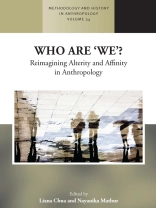Who do “we” anthropologists think “we” are? And how do forms and notions of collective disciplinary identity shape the way we think, write, and do anthropology? This volume explores how the anthropological “we” has been construed, transformed, and deployed across history and the global anthropological landscape. Drawing together both reflections and ethnographic case studies, it interrogates the critical—yet poorly studied—roles played by myriad anthropological “we” as in generating and influencing anthropological theory, method, and analysis. In the process, new spaces are opened for reimagining who “we” are – and what “we, ” and indeed anthropology, could become.
Inhoudsopgave
List of Figures
Acknowledgements
Introduction: Who Are ‘We’?
Liana Chua and Nayanika Mathur
PART I: REVISITING THE ANTHROPOLOGICAL ‘WE’
Chapter 1. Anthropology at the Dawn of Apartheid: Radcliffe-Brown and Malinowski’s South African Engagements, 1919-1934
Isak Niehaus
Chapter 2. The Savage Noble: Alterity and Aristocracy in Anthropology
David Sneath
PART II: ALTERITY AND AFFINITY IN ANTHROPOLOGY’S GLOBAL LANDSCAPE
Chapter 3. The Anthropological Imaginarium: Crafting Alterity, the Self, and an Ethnographic Film in Southwest China
Katherine Swancutt
Chapter 4. The Risks of Affinity: Indigeneity and Indigenous Film Production in Bolivia
Gabriela Zamorano Villarreal
Chapter 5. Shifting the ‘We’ in Oceania: Anthropology and Pacific Islanders Revisited
Ty P. Kāwika Tengan
PART III: WHERE DO ‘WE’ GO FROM HERE?
Chapter 6. Crafting Anthropology Otherwise: Alterity, Affinity, and Performance
Gey Pin Ang and Caroline Gatt
Chapter 7. Towards an Ecumenical Anthropology
João de Pina-Cabral
Afterword
Mwenda Ntarangwi
Index
Over de auteur
Nayanika Mathur is Professor of Anthropology and South Asian Studies at the University of Oxford. Her publications include Paper Tiger: Law, Bureaucracy, and the Developmental State in Himalayan India (Cambridge, 2016) and Crooked Cats: Beastly Encounters in the Anthropocene (Chicago, 2021) as well as co-edited volumes on anthropological methods and Indian politics.












